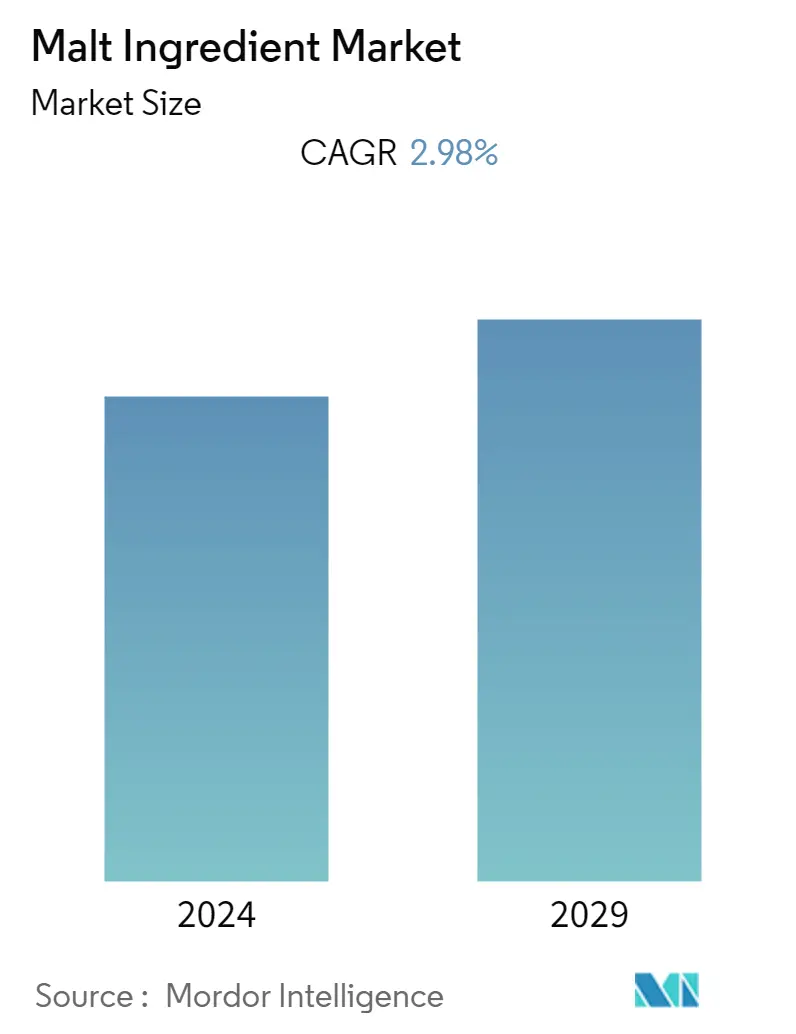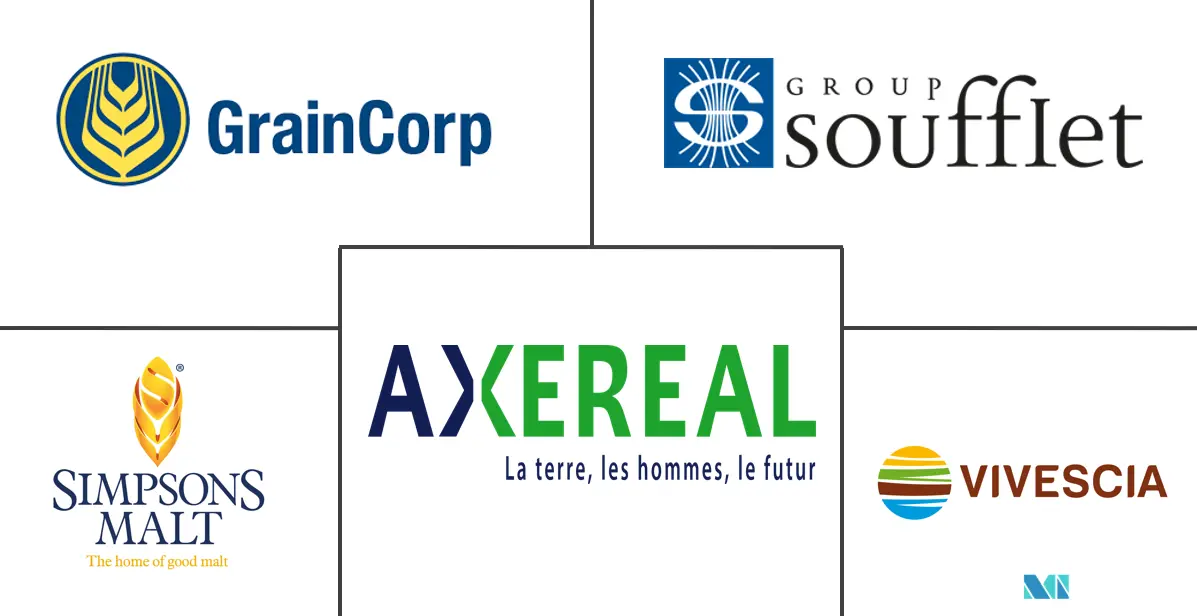
| Study Period | 2019 - 2029 |
| Base Year For Estimation | 2023 |
| Forecast Data Period | 2024 - 2029 |
| CAGR | 2.98 % |
| Fastest Growing Market | Asia Pacific |
| Largest Market | Europe |
| Market Concentration | Low |
Major Players
*Disclaimer: Major Players sorted in no particular order |
Malt Ingredients Market Analysis
The malt ingredient market is projected to register a CAGR of 2.98% during the forecast period.
- The global malt ingredients market is experiencing significant growth due to several factors. Firstly, the market is being driven by the rising demand for plant-based ingredients and natural sweeteners, as well as the growing demand for versatile and sustainable ingredients among brewers. Malt is a healthy alternative to traditional sweeteners, improves color, and enhances the taste and texture of food and beverage products, making it a popular choice among food and beverage manufacturers.
- The increasing demand for alcoholic beverages, such as whiskey, beer, vodka, scotch, and non-alcoholic beverages, is another factor contributing to the growth of the global malt ingredients market. Consumers are increasingly seeking distinctive and flavorful beers, which is further pushing the growth of malt ingredients in the beer industry. The demand for the craft brewing and distilling industries has experienced significant growth during the past few years, which signifies the vast expansion of the global malt ingredient market.
- The demand for low-alcoholic beverages has also been rising with the growing interest of health-conscious consumers. Key players in the market are offering a wider choice of new product ranges, with improved taste and low alcoholic content in beer for those of 2.8% ABV and less. This drives the demand for malt ingredients among beer manufacturers. Many local brewers are offering local, sustainable, innovative, and handcrafted beers to customers.
- Millennials prefer ethnic premium, super-premium spirits, and flavored spirits, which include craft and artisanal varieties. An increasing number of consumers are looking for new and more exciting offerings compared to their usual spirit options, pushing up the revenue generation of malt ingredients among alcoholic beverage manufacturers.
- The market is also benefiting from the growing number of breweries. According to the Brewers of Europe, the number of breweries in the European Union increased from 9,206 in 2020 to 9,436 in 2021. Overall, the global malt ingredients market is poised for robust growth due to several factors, including the rising demand for plant-based ingredients, growing demand for versatile and sustainable ingredients among brewers, increasing demand for low-alcoholic beverages, and the growing number of breweries.
Malt Ingredients Industry Segmentation
Malt is a grain product that is used as a key ingredient in a wide range of food and beverages to add nutrients and flavor to the product and as a basis for fermentation.
The scope of the malt ingredient market includes segmentation of the market based on source, application, and geography. By source, the market is segmented into barley, wheat, and other sources. By application, the market is segmented into alcoholic beverages, non-alcoholic beverages, food, pharmaceutical, and animal feed. By geography, the market is segmented into North America, Europe, Asia-Pacific, South America, and Middle East and Africa.
For each segment, the market sizing and forecasts have been done on the basis of value (in USD million).
| Barley |
| Wheat |
| Other Sources |
| Alcoholic beverages |
| Non-alcoholic beverages |
| Food |
| Pharmaceutical |
| Animal Feed |
| North America | United States |
| Canada | |
| Mexico | |
| Rest of North America | |
| Europe | Spain |
| United Kingdom | |
| Germany | |
| France | |
| Italy | |
| Russia | |
| Rest of Europe | |
| Asia-Pacific | China |
| Japan | |
| India | |
| Australia | |
| Rest of Asia-Pacific | |
| South America | Brazil |
| Argentina | |
| Rest of South America | |
| Middle-East and Africa | South Africa |
| United Arab Emirates | |
| Rest of Middle-East and Africa |
Malt Ingredient Market Size Summary
The global malt ingredients market is experiencing robust growth, driven by the increasing demand for plant-based and natural sweeteners, as well as the need for versatile and sustainable ingredients among brewers. Malt's ability to enhance flavor, color, and texture makes it a preferred choice for food and beverage manufacturers. The rising consumption of alcoholic beverages, particularly beer, is a significant factor propelling market expansion. Consumers' preference for distinctive and flavorful beers, alongside the growth of craft brewing and distilling industries, underscores the market's potential. Additionally, the demand for low-alcoholic beverages is rising, catering to health-conscious consumers, further boosting the market for malt ingredients.
Europe holds a significant share of the malt ingredients market, fueled by the increasing consumption of alcoholic beverages and the adoption of specialty malt in breweries. The region's craft breweries and the demand for locally brewed beers are key contributors to market growth. Malt's application extends beyond brewing, finding uses in bakeries, snacks, and the food industry as a natural flavoring agent. The market is highly fragmented, with numerous global and regional players competing for market share. Companies are focusing on product innovation and strategic partnerships to expand their offerings and enter new applications, enhancing their competitive edge in the global market.
Malt Ingredient Market Size - Table of Contents
1. MARKET DYNAMICS
- 1.1 Market Drivers
- 1.2 Market Restraints
-
1.3 Porter's Five Forces Analysis
- 1.3.1 Threat of New Entrants
- 1.3.2 Bargaining Power of Buyers/Consumers
- 1.3.3 Bargaining Power of Suppliers
- 1.3.4 Threat of Substitute Products
- 1.3.5 Intensity of Competitive Rivalry
2. MARKET SEGMENTATION
-
2.1 Source
- 2.1.1 Barley
- 2.1.2 Wheat
- 2.1.3 Other Sources
-
2.2 Application
- 2.2.1 Alcoholic beverages
- 2.2.2 Non-alcoholic beverages
- 2.2.3 Food
- 2.2.4 Pharmaceutical
- 2.2.5 Animal Feed
-
2.3 Geography
- 2.3.1 North America
- 2.3.1.1 United States
- 2.3.1.2 Canada
- 2.3.1.3 Mexico
- 2.3.1.4 Rest of North America
- 2.3.2 Europe
- 2.3.2.1 Spain
- 2.3.2.2 United Kingdom
- 2.3.2.3 Germany
- 2.3.2.4 France
- 2.3.2.5 Italy
- 2.3.2.6 Russia
- 2.3.2.7 Rest of Europe
- 2.3.3 Asia-Pacific
- 2.3.3.1 China
- 2.3.3.2 Japan
- 2.3.3.3 India
- 2.3.3.4 Australia
- 2.3.3.5 Rest of Asia-Pacific
- 2.3.4 South America
- 2.3.4.1 Brazil
- 2.3.4.2 Argentina
- 2.3.4.3 Rest of South America
- 2.3.5 Middle-East and Africa
- 2.3.5.1 South Africa
- 2.3.5.2 United Arab Emirates
- 2.3.5.3 Rest of Middle-East and Africa
Malt Ingredients Market Research FAQs
What is the current Malt Ingredient Market size?
The Malt Ingredient Market is projected to register a CAGR of 2.98% during the forecast period (2025-2030)
Who are the key players in Malt Ingredient Market?
Axereal, GrainCorp Limited, VIVESCIA, Soufflet Group and Simpsons Malt Limited are the major companies operating in the Malt Ingredient Market.


